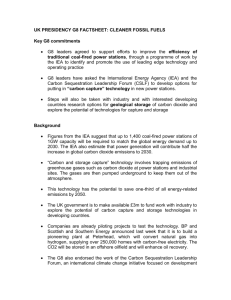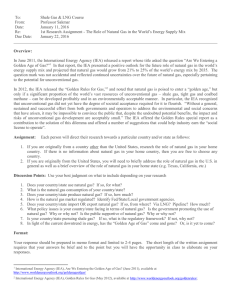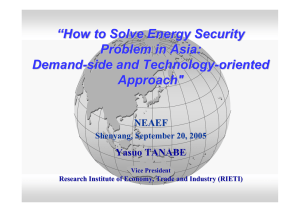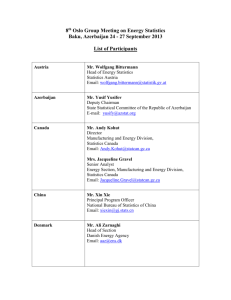Looking Ahead to the Next 30 years of the... From Japan’s Perspective
advertisement
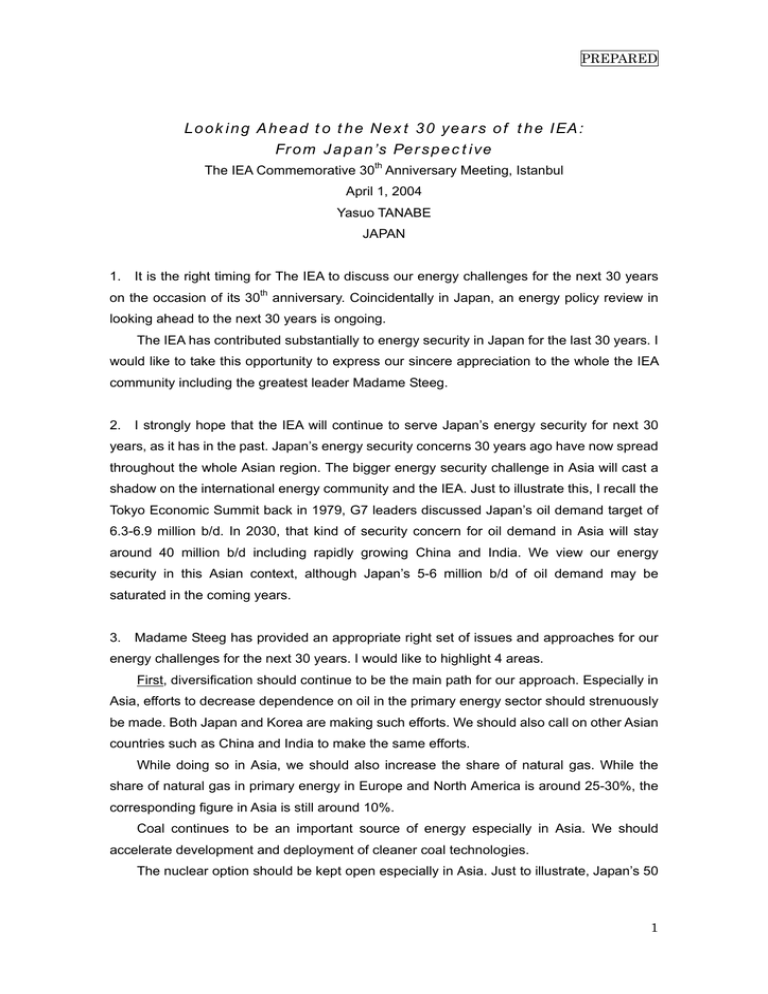
PREPARED Looking Ahead to the Next 30 years of the IEA: From Japan’s Perspective The IEA Commemorative 30th Anniversary Meeting, Istanbul April 1, 2004 Yasuo TANABE JAPAN 1. It is the right timing for The IEA to discuss our energy challenges for the next 30 years on the occasion of its 30th anniversary. Coincidentally in Japan, an energy policy review in looking ahead to the next 30 years is ongoing. The IEA has contributed substantially to energy security in Japan for the last 30 years. I would like to take this opportunity to express our sincere appreciation to the whole the IEA community including the greatest leader Madame Steeg. 2. I strongly hope that the IEA will continue to serve Japan’s energy security for next 30 years, as it has in the past. Japan’s energy security concerns 30 years ago have now spread throughout the whole Asian region. The bigger energy security challenge in Asia will cast a shadow on the international energy community and the IEA. Just to illustrate this, I recall the Tokyo Economic Summit back in 1979, G7 leaders discussed Japan’s oil demand target of 6.3-6.9 million b/d. In 2030, that kind of security concern for oil demand in Asia will stay around 40 million b/d including rapidly growing China and India. We view our energy security in this Asian context, although Japan’s 5-6 million b/d of oil demand may be saturated in the coming years. 3. Madame Steeg has provided an appropriate right set of issues and approaches for our energy challenges for the next 30 years. I would like to highlight 4 areas. First, diversification should continue to be the main path for our approach. Especially in Asia, efforts to decrease dependence on oil in the primary energy sector should strenuously be made. Both Japan and Korea are making such efforts. We should also call on other Asian countries such as China and India to make the same efforts. While doing so in Asia, we should also increase the share of natural gas. While the share of natural gas in primary energy in Europe and North America is around 25-30%, the corresponding figure in Asia is still around 10%. Coal continues to be an important source of energy especially in Asia. We should accelerate development and deployment of cleaner coal technologies. The nuclear option should be kept open especially in Asia. Just to illustrate, Japan’s 50 1 PREPARED nuclear power plants, which have been the product of strenuous policy efforts until now, have saved about 2 million b/d of oil, which might have been consumed as electricity fuel. Introducing renewable energies is a challenge when we think of the high cost and large energy demand growth in Asia. All of this diversification should be realized through market-friendly policies. This is the most difficult part of the story. Especially in Asia, examining how to introduce these kinds of policies while promoting market development and economic growth should be an ongoing process. 4. Secondly, there is large potential and necessity for energy efficiency. Just to illustrate, about a quarter of energy in the whole the IEA members could be saved if the lowest level of energy intensity among the IEA members could be achieved throughout all member countries. In Asia, energy efficiency is critical when we think of the large growth in demand. More than half of energy consumption in Asia, which would be expected to double in the next 30 years, could be saved if all Asian countries could achieve the Japanese level of energy intensity. Furthermore, we should expect large energy savings and improvements in efficiency with development and deployment of new technologies. We have already had CCGT in electricity and hybrid engines in automobiles to name a few examples of available technologies. Why not more? We should boldly aim for ‘Factor X’. 5. Thirdly, it is essential to have dialogue, mutual understanding and cooperation between producer countries and consumer countries to the next future challenges in energy supply and demand. 30 years ago, the IEA was founded to counter the power of OAPEC. The IEA has had the leverage of strategic oil stockpiles and policies of diversification and energy efficiency. The leverage has worked. Since then, the international energy situation, in particular, the oil situation has changed. It is natural and healthy for the IEA and OPEC to have started and intensified the dialogue. Personally I recall 1982, When my boss the former MITI Minister Abe proposed the concept of the “producer-consumer dialogue” at the IEA Ministerial. It started in 1991 and took big steps forward in 2000 in Riyadh and in 2002 in Osaka. Both producers and consumers have common interests in stable energy markets, which are a prerequisite for achievable policy goals, such as diversification. JODI is the best example of a positive step for a producer-consumer cooperation. For the shorter term, the recent OPEC production policy poses us a challenge for our capability of dialogue. The 9th 2 PREPARED IEF next month in Amsterdam will be a good opportunity to talk about a broader range of issues of common interest. 6. Fourthly, regional integration is an unavoidable trend. The right approach is necessary to utilize its merits to cope with negative effects within each region of North America, Europe and Asia, taking into consideration of characteristics of the regions. The biggest challenge, in my view, lies in Asia. The geographical gravity of world energy demand will shift to Asia in the next 30 years. Regional energy integration in Asia at this moment is far behind North America and Europe. But, economic integration in Asia is on the way, both in economic reality and in legal framework, following North America and Europe. Energy aspects of Asian regional integration have caught many people’s attentions recently. Many Asian countries are well aware that energy security in each country cannot stand alone without regional energy security. That is why nowadays Japan and Korea are in agreement that both countries should take joint leadership of Asian energy security. A new group called ASEAN+3 (China, Japan and Korea) has been active in recent years. APEC, with Australian leadership, has been useful in sharing various experiences and information among diversified members. There is also an idea to discuss Northeast Asian energy cooperation including Russia. One of the biggest challenges for an integrated Asia as a big consumer, in my view, is how to manage the relationship with Middle-eastern oil producing countries. Sometimes this relationship is called “East and West Asia” or “Greater Asia”. However, Asian countries decisively lack experiences in the Middle-east in the modern age of oil. While Japan should be in a position to play a leadership role in this Asian energy integration, experiences and information from the IEA will be welcomed. But, here too, how to interact with Asia is a big challenge for the IEA. 7. Finally, I would like to make a provocative suggestion to the IEA, in a personal capacity, for the purpose of animated discussion. Why not the IEA move to either Tokyo, Shanghai or Singapore in the next 30 years? Also, why not include countries like China, India and Russia as the IEA members? Perhaps a more reasonable and realistic proposal may be, why don’t we have GB meetings in the Asia-Pacific region. Ten years ago, the 20th commemorative GB meeting was held in Kyoto. Now we are in Istanbul. Why don’t we have more meetings east of the Bosphorus? I would like to thank the Turkish government for making this commemorative meeting possible here in the beautiful city of Istanbul bridging Europe and Asia. 3 PREPARED Thank you for your attention. 4
